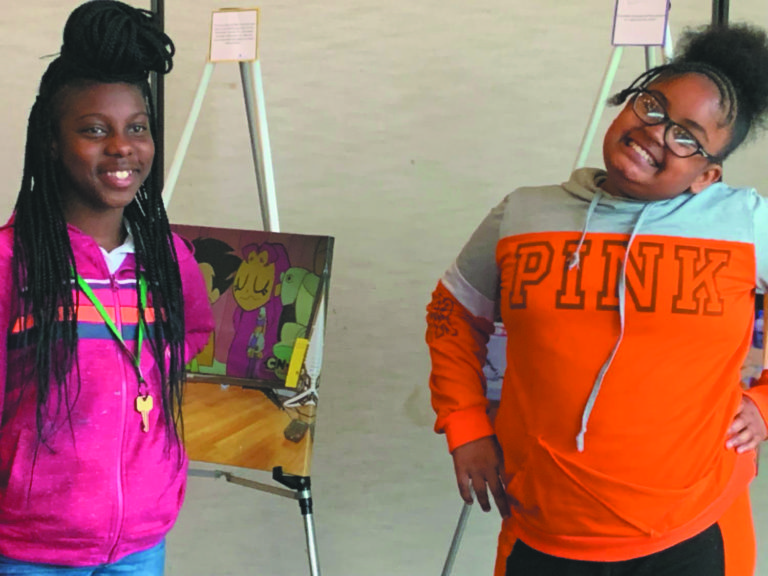

By Nicholas Garton
Madison365
A group of children living on Madison’s north side identified bullying as the biggest issue influencing their health — and that was the one thing they couldn’t identify through the art of photography at an exhibit at the Warner Park Community Center this week.
When Dr. Eva Vivian, a professor at the University of Wisconsin School of Pharmacy, read about the disparity in health outcomes for people of color in the 2013 Race to Equity report, she wondered what that meant specifically for the future of children in communities of color.
Dr. Vivian wanted to know what children would say if they were asked to identify the things that most influence their health.
“The Race To Equity report indicates that African American children and other children of color are at higher risk of living in poverty in Wisconsin,” Dr. Vivian told Madison365. “And they have poorer health outcomes. When I was hearing all these statistics, I’m thinking, ‘well who is talking to the children?’ We have all these researchers coming into communities conducting interventions but what do the children feel influences their health? What do they feel that they need?”
Dr. Vivian then sought to bring children from the Northport Drive and Packers Avenue area together and give them a project. She gave each one of them a camera and trained them in photography so that they could go through the community and photograph things that they felt influenced their health.
Some took photos of the trash around the areas where they live and play. The kids raised concerns about how their health is affected by being around all the litter and garbage in the area, and how that affected animals in the area as well.
One child photographed the Northport Ave McDonald’s and the treacherously busy streets she has to cross in order to go there for food. Another child, a 13 year old named Krista, told Madison365 that she photographed the playground because while it is fun to go there and play, food trucks that come to provide them with meals just toss their trash out onto the playground until she and her friends go outside to clean it up.
The photographs ranged from seatbelts to fast food to play areas and were on display during an event Wednesday night at the Warner Park Community Center. Kids stood next to the photographs that they had taken and had dinner. The event was sponsored by the Madison Links, the African American Health Network, Northport Community Learning Center and UW Madison School of Pharmacy.
Each photograph told a story about what our youth go through on a daily basis. Well, almost.
When Dr. Vivian gathered the children after their projects were finished, she asked the kids if there was anything they wish they had been able to photograph in addition to the ones they had done. Their answer was unanimous and startling: They wished they had been able to photograph bullies in the act of bullying. That was the number one thing they felt influenced their health.
“The University wouldn’t allow me to let them take pictures of other people,” Dr. Vivian explained. “So I asked them if there was anything they wish they could have taken a picture of and that’s how the discussion of bullying came up. Because you can’t take a picture of someone bullying. The number one concern was bullying. The children thought that bullying hurt them, they saw bullying affect their friends. One girl told me that her brother committed suicide as a result of bullying.”
The depression that accompanies bullying is different today than in any previous generation. Kids feel a level of helplessness because victims of bullying are victimized everywhere. During school, after school, online, over the phone, over the computer. It’s endless and often inescapable.
“So bullying is a lot different than when we were kids,” Dr. Vivian said. “Because now kids can get on phones and social media and bully another peer in front of like hundreds of kids. What we’re hoping to do in the future is offer an anti-bullying program not just for kids but for the adults. A 10-year-old girl who is in the program told me that adults don’t know bullying when they see it and when they see it they don’t know what to do about it. At school, for example, some of the teachers may tell the children ‘Oh just get over that, that’s no big deal.’ One girl said she was pushed all the way down and beat up and no one did anything about it and as a result she was cutting herself. So now she’s seeing a therapist. So these children go through a lot and often we don’t know it because we don’t ask.”
Dr. Vivian was taken aback she said at the velocity of the feelings the kids in the program expressed about the bullying that they and people close to them endure. In the center of the community room at the Warner Park Community Center were two posters the children had drawn to be anti-bullying artwork since they had not been able to photograph it.
Clean Environments and Family/Friends were the second and third ranked things the children identified as influencing their health.
“They said despite all the challenges they face, they really are happy to have their parents and their family and friends,” Dr. Vivian said. “So this is really great to see.”
The children’s photographs are going to be displayed on the campus at UW Madison for a period of time along with index cards that explain a little bit about each photograph. Eventually, the kids will get the photographs back to be displayed around their homes and community.